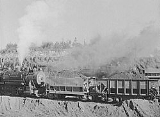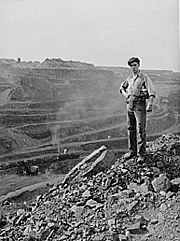
Hull-Rust-Mahoning Open Pit Iron Mine
Encyclopedia
The Hull-Rust-Mahoning Mine in Hibbing
, Minnesota
, is one of the largest open pit iron mine
s in the world. The mine, located in the Mesabi Range
, supplied as much as one-fourth of all the iron ore mined in the United States
during its peak production during World War I
and World War II
.
 This area of the Mesabi Range was explored in 1893–1894, shortly after the Mountain Iron
This area of the Mesabi Range was explored in 1893–1894, shortly after the Mountain Iron
mine was established in 1892. The early development was as an underground mine, but open pit mining soon proved to be a better choice because of the shallow nature of the ore deposits. The many smaller open pit mines developed in the area soon merged into one large mine. The growth of the mine even resulted in the town of Hibbing being relocated to accommodate expansion. The move started in 1919 and took two years to complete at a cost of $16,000,000. 185 houses and 20 businesses were moved, and some of the larger buildings had to be cut in half for the move. Only a few uninhabited remnants of the original townsite are left near an observational lookout at the edge of the mine.
Over 519 million tons of waste material and 690 million tons of iron ore have been removed from the mine area since ore shipments began in 1895. The mine was listed as a National Historic Landmark
, and added to the National Register of Historic Places
on November 13, 1966. The mine is still operated today by the Hibbing Taconite Company, and iron ore "taconite
" pellets are produced at the rate of 8.2 million tons annually (not counting tailings, waste rock, or overburden
).
Hibbing, Minnesota
Hibbing is a city in Saint Louis County, Minnesota, United States. The population was 16,361 at the 2010 census. The city was built on the rich iron ore of the Mesabi Iron Range. At the edge of town is the largest open-pit iron mine in the world. U.S...
, Minnesota
Minnesota
Minnesota is a U.S. state located in the Midwestern United States. The twelfth largest state of the U.S., it is the twenty-first most populous, with 5.3 million residents. Minnesota was carved out of the eastern half of the Minnesota Territory and admitted to the Union as the thirty-second state...
, is one of the largest open pit iron mine
Open-pit mining
Open-pit mining or opencast mining refers to a method of extracting rock or minerals from the earth by their removal from an open pit or borrow....
s in the world. The mine, located in the Mesabi Range
Mesabi Range
The Mesabi Iron Range is a vast deposit of iron ore and the largest of four major iron ranges in the region collectively known as the Iron Range of Minnesota. Discovered in 1866, it is the chief deposit of iron ore in the United States. The deposit is located in northeast Minnesota, largely in...
, supplied as much as one-fourth of all the iron ore mined in the United States
United States
The United States of America is a federal constitutional republic comprising fifty states and a federal district...
during its peak production during World War I
World War I
World War I , which was predominantly called the World War or the Great War from its occurrence until 1939, and the First World War or World War I thereafter, was a major war centred in Europe that began on 28 July 1914 and lasted until 11 November 1918...
and World War II
World War II
World War II, or the Second World War , was a global conflict lasting from 1939 to 1945, involving most of the world's nations—including all of the great powers—eventually forming two opposing military alliances: the Allies and the Axis...
.

Mountain Iron, Minnesota
As of the census of 2000, there were 2,999 people, 1,326 households, and 847 families residing in the city. The population density was 60.7 people per square mile . There were 1,409 housing units at an average density of 28.5 per square mile...
mine was established in 1892. The early development was as an underground mine, but open pit mining soon proved to be a better choice because of the shallow nature of the ore deposits. The many smaller open pit mines developed in the area soon merged into one large mine. The growth of the mine even resulted in the town of Hibbing being relocated to accommodate expansion. The move started in 1919 and took two years to complete at a cost of $16,000,000. 185 houses and 20 businesses were moved, and some of the larger buildings had to be cut in half for the move. Only a few uninhabited remnants of the original townsite are left near an observational lookout at the edge of the mine.
Over 519 million tons of waste material and 690 million tons of iron ore have been removed from the mine area since ore shipments began in 1895. The mine was listed as a National Historic Landmark
National Historic Landmark
A National Historic Landmark is a building, site, structure, object, or district, that is officially recognized by the United States government for its historical significance...
, and added to the National Register of Historic Places
National Register of Historic Places
The National Register of Historic Places is the United States government's official list of districts, sites, buildings, structures, and objects deemed worthy of preservation...
on November 13, 1966. The mine is still operated today by the Hibbing Taconite Company, and iron ore "taconite
Taconite
Taconite is a variety of iron formation, an iron-bearing sedimentary rock, in which the iron minerals are interlayered with quartz, chert, or carbonate...
" pellets are produced at the rate of 8.2 million tons annually (not counting tailings, waste rock, or overburden
Overburden
Overburden is the material that lies above an area of economic or scientific interest in mining and archaeology; most commonly the rock, soil, and ecosystem that lies above a coal seam or ore body. It is also known as 'waste' or 'spoil'...
).

